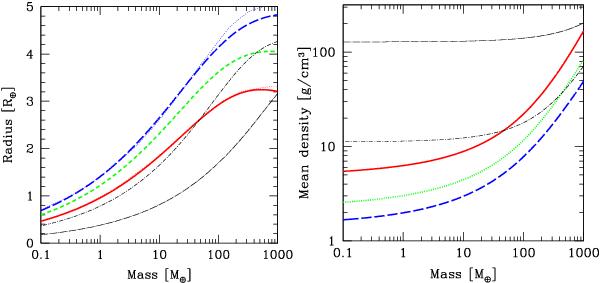Fig. 1

Total planetary or core radii and mean densities as a function of mass for different compositions. The red solid curve corresponds to a rocky planet with a 2:1 silicate-to-iron ratio, similar to Earth. The green dotted curve is for planets consisting of 50% ice, 33% silicates and 17% iron. The blue dashed line shows radii for planets consisting entirely of ice. These three models are calculated without an external pressure on the surface and, therefore, apply to low-mass planets without significant envelopes. The thin red and blue dotted lines show the result from Seager et al. (2007) for comparison. The thin black lines correspond to cores of giant planets. The short-dashed-dotted line is for a 75% ice, 25% rocky core inside an old, Jovian mass planet (Pext = 4 × 1013 dyn/cm2). The long-dashed-dotted line is for a core of the same composition inside an old, 10 MX super-Jupiter planet (Pext = 6 × 1015 dyn/cm2).
Current usage metrics show cumulative count of Article Views (full-text article views including HTML views, PDF and ePub downloads, according to the available data) and Abstracts Views on Vision4Press platform.
Data correspond to usage on the plateform after 2015. The current usage metrics is available 48-96 hours after online publication and is updated daily on week days.
Initial download of the metrics may take a while.




